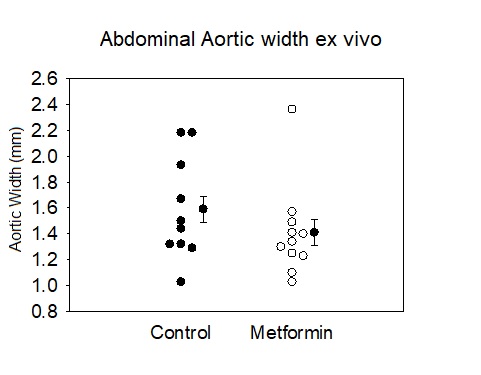Metformin Does Not Attenuate Angiotensin II-Induced Abdominal Aortic Aneurysms in Low-Density Lipoprotein Receptor Deficient Mice
Sam Tyagi1, Deborah Howatt1, Michael Franklin1, Eric Endean1, Eugene Lee2, Hong Lu1, Alan Daugherty1
1University of Kentucky, Lexington, KY;2University of California Davis, Sacremento, CA
INTRODUCTION: Despite significant efforts to identify medical therapy on aneurysm growth, no effective substance has been approved for treating patients. Recent retrospective Veterans Affairs database studies have shown decreased abdominal aortic aneurysm (AAA) formation and growth in diabetic patients who are treated with metformin. Additionally, there is some preclinical evidence showing that hyperglycemia and metformin decrease elastase-induced AAA formation in mice. In this study, we evaluated the effects of metformin on angiotensin II-induced AAA formation in mice.
METHODS: Male low-density lipoprotein receptor deficient (LDLr -/- ) mice at the age of 9 weeks were administered metformin (300 mg/kg/d) in drinking water or drinking water alone through the study period (N = 12/group). Three days later, a saturated fat-enriched diet was begun to induce hypercholesterolemia. One week after the initiation of this special diet, all mice had mini osmotic pumps (Alzet Model 2004) subcutaneously implanted to deliver angiotensin II (1000 ng/kg/minute) for 4 weeks. After termination, aortas were dissected, fixed, cleaned, and imaged ex vivo. Maximal aortic diameters were measured according to our standard technique.
RESULTS: Two mice in the control group and one mouse in the metformin group died due to aortic rupture in the abdominal region. No differences of maximal diameters were detected between the two groups (control versus metformin: 1.6 ± 0.1 mm versus 1.4 ± 0.1 mm, P = 0.3 by Student’s t-test). The incidence of AAA was based on abdominal aortic aneurysm rupture or 50% increase of normal aortic diameter (based on previous studies showing ~ 0.9 mm is the mean of normal aortic diameter). No difference of AAA incidence was noted (control versus metformin: 8 of 12 versus 6 of 12, P = 0.7 by Fisher Exact test).
CONCLUSIONS: Despite the human clinical observation, metformin did not attenuate angiotensin II-induced AAA in mice. Hyperglycemia may have been the driving force in the human clinical database findings. Further investigation will be needed to determine whether hyperglycemia in combination with metformin reduces angiotensin-II induced AAA and into the mechanism of hyperglycemia attenuation of AAA. 

Back to 2020 Abstracts
